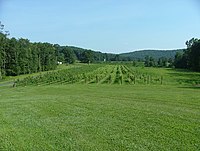| Wine region | |
 | |
| Official name | State of North Carolina |
|---|---|
| Type | U.S. State Appellation |
| Years of wine industry | 501 |
| Country | United States |
| Sub-regions | Appalachian High Country AVA, Crest of the Blue Ridge Henderson County AVA, Haw River Valley AVA, Swan Creek AVA, Upper Hiwassee Highlands AVA, Yadkin Valley AVA |
| Climate region | Humid subtropical (maritime in highlands) |
| Total area | 53,865 square miles (139,510 km) |
| No. of vineyards | 500+ |
| Grapes produced | Cabernet Franc, Cabernet Sauvignon, Carlos, Cayuga, Chambourcin, Chancellor, Chardonel, Chardonnay, Concord, De Chaunac, Gewürztraminer, Leon Millot, Malbec, Merlot, Mourvèdre, Muscadine, Muscat Canelli, Nebbiolo, Niagara, Noble, Norton, Petit Verdot, Pinot gris, Pinot Noir, Riesling, Sangiovese, Sauvignon blanc, Scuppernong, Seyval blanc, St. Vincent, Symphony, Syrah, Tempranillo, Traminette, Vidal blanc, Vignoles, Viognier |
| No. of wineries | 250 |
Wine has been produced in the North Carolina area since the early days of European colonization in the 17th century. Wine growers in North Carolina were the first to cultivate a Native American grape variety, the Scuppernong, which produces a sweet wine, examples of which are still being made in the state. Most wine produced in North Carolina since the year 1972 is made from Vitis vinifera grape varieties, although French hybrid and Vitis labrusca varieties remain common.
Viticulture History
The first cultivated wine grape in the United States was grown in North Carolina. The first known recorded account of the Scuppernong grape in North Carolina is found in the logbook of explorer Giovanni da Verrazzano. He wrote in 1524, "Many vines growing naturally there that would no doubt yield excellent wines." The grape was the primary source for North Carolina's 19th Century wine, as it had been for about two centuries. In its place is an increased interest in grape growing, which is rooted in pre-colonial North Carolina’s history. In the mid-19th Century, there were some 25 wineries in North Carolina, with extensive independent vineyards, to such an extent that North Carolina dominated the national market for American wines at the time. The Civil War ended that market dominance, through damage to the industry by loss of manpower and scarce capital, as well as through revocation of wine-making licenses due to regulatory retribution following the war. Wine production began to recover in the decades after the war through the early 20th Century. However, North Carolina voted to become a dry state in 1908 and that decision, coupled with the onset of Prohibition, ended wine-making in North Carolina. Repeal in 1933, followed by the passage by North Carolina's legislature in 1935 of laws permitting wine-making, began a rebirth, but it was several decades after World War II before North Carolina's wine industry would show significant growth.


Modern wine industry
Further information: Appalachain High Country AVANorth Carolina ranks tenth in both grape and wine production in the United States. One of the first modern major plantings of vinifera grapes in North Carolina occurred in 1972, when Jack Kroustalis established Westbend Vineyards, located in the Yadkin Valley. According to "Carolina Wine Country," "he vines flourished in the rich soil of the Yadkin River Valley." In 1988, Kroustalis built the first bonded winery in the Yadkin Valley. Other growers in Yadkin Valley took note of Westbend Vineyard’s success with vinifera grapes and followed suit. Yadkin Valley was recognized in 2003 as the state's first American Viticultural Area (AVA). Since then, its viticulture industry continues to expand and presently is one of the nation's top five state destinations for enotourism garnering vintage awards and recognition competing with California, Oregon, Washington and Virginia. In 2007, North Carolina contained 55 wineries and 350 vineyards. By 2011, this had grown to more than 100 wineries and 400 vineyards. As of 2024, North Carolina is resident to 6 unique AVAs, 250 wineries and 500+ vineyard sites, a fact that underscores the state’s growing reputation as a major viticulture region.
See also
References
- ^ "North Carolina: Appellation Profile". Appellation America. 2007. Archived from the original on October 2, 2023. Retrieved September 17, 2024.
- ^ Hines, Nickolaus (September 11, 2015). "Muscadine: The Grape of the South". Grape Collective. Archived from the original on April 27, 2021.
- ^ "Swan Creek Wine Trail" (About). 2024. Retrieved October 17, 2024.
Today, NC is home to 6 different AVAs and 500+ vineyard sites
- ^ "Wine: A wine history well-aged". NC - Visit North Carolina. 2024. Archived from the original on July 13, 2024. Retrieved October 17, 2024.
- Taplin, Ian M. (January 20, 2016). The Modern American Wine Industry: Market Formation and Growth in North Carolina. Routledge. ISBN 9781317322832. Retrieved April 27, 2016.
- "Yadkin Valley Viticultural Area (2001R–88P)" (27 CFR Part 9 RIN 1512–AC82 Final Rule). Federal Register. 67 (236). Bureau of Alcohol, Tobacco and Firearms (ATF), Treasury: 72834–72840. December 9, 2002.
 This article incorporates text from this source, which is in the public domain.
This article incorporates text from this source, which is in the public domain.
- "Visit NC Wine Country". North Carolina Wine Gifts.com. Archived from the original on September 5, 2012. Retrieved October 6, 2012.
- "Nurture Wine and Grape Industry". North Carolina Department of Commerce. Archived from the original on February 16, 2008. Retrieved August 9, 2012.
- "NC Wine Fast Facts" (PDF). North Carolina Wine & Grape Industry. Archived from the original (PDF) on March 3, 2016. Retrieved August 9, 2012.
